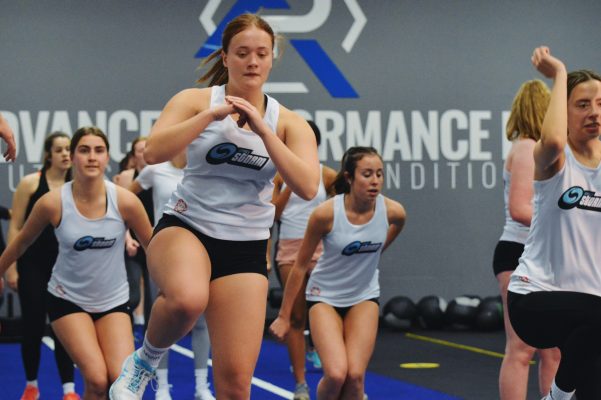The ability to jump, sprint and to change direction quickly are athletic qualities which are desirable for all athletes, as these athletic qualities are key elements which can help in sporting performances. Collectively and traditionally, these athletic qualities or movements (sprint, jump and agility) fall into a family of drills known as plyometrics, as plyometrics utilise a complex mechanism; the stretch-shortening cycle (SSC).
The SSC mechanism is controlled both by neural and muscular factors (Nicol at al. 2006), and within activities which utilise the SSC, the muscular system is taken through an eccentric (lengthening) action, followed by an isometric action, and a powerful concentric (shortening) action. These series of actions (interaction of the neural and muscular systems) are vital in young athletic development, as they seem to naturally develop (Llyod et al. 2011), but also seem to be highly trainable, as performances have been reported in jump height (Chaabene & Negra, 2017), agility (Bal et al. 2011) and running speeds (Chelly et al. 2015) after training to develop the SSC elements.
As the SSC is demanding on the neural and muscular systems, especially as eccentric actions occur mostly in the muscular-tendon junction, the appropriateness of plyometric training has been questioned for young athletes, namely young athletes before going through peak-height velocity (PHV). However, as plyometric activities are routinely observed in free-play with no supervision or coaching, it seems that locomotive activities (skipping, hopping, jumping, and running) within free-play will drive specific adaptations to enhance the SSC.
Therefore, as the SSC seems essential for long-term development of all young athletes (pre and post PHV), this blog will give some areas of considerations so that plyometric drills can be explored and used as an effective and engaging LTAD training modality.
Plyometrics and Pre-Peak Height Velocity
Common to most myths and misunderstandings, plyometrics are appropriate for all ages and abilities, as previously mentioned young children and athletes naturally hop, skip, jump, and sprint in free play, which can all be classified as plyometrics. However, maturation (along with strength training and general training experience) will to a point dictate plyometric or SSC development.
Young athletes (under 12yrs, Pre PHV), with low strength levels and training experience have been shown to have less age-related development, which could alter SSC mechanisms including, tendon stiffness, use a medium or late reflex, which probably alters the forward feed system resulting in less muscular pre-activation strategies (Radnor et al. 2018. This collectively leads to a greater or longer ground contact time, as the system needs a longer duration to generate force. This is all fine, as the athlete needs training and time to develop these qualities, they simply cannot get faster overnight!
Expose young athletes to strength training to prepare for plyometrics
With younger, less experienced athletes, it is important that they are exposed to general strength training, as this will lead to neuromuscular adaptations, for example, developing tendon stiffness and muscular coordination, which also can be viewed as a prerequisite to plyometric training. By exposing strength exercises (squats, deadlifts, and lunges), these exercises teach all aspects of muscular contraction (eccentric, isometric and concentric) relative to the external load, whilst also teaching the young athlete to control their posture/motor control.
Types of Drills
With Plyometric drills, start with drills which are mostly vertical and bi-lateral, as this will help the athlete to learn coordination, but also the athlete can start to develop shorter ground-contact times. As the athlete develops, utilise a range of hops and skips, which start to incorporate both vertical and horizontal movements.

Volume, Velocity and Frequency
With young athletes, keep the training volume and frequency low. Training volume is normally calculated by ‘foot contacts’ (see table below). Typically, frequency is prescribed as twice per week, on non-consecutive days. With young athletes learning hops and skips, normally coordination and rhythm will take priority. As the young athlete develops further, quality of the movement is more important than quantity, with the main aim of the plyometric drill being to reduce ground-contact time.
Post-Peak Height Velocity
Older athletes (Post PHV) should be exposed to a level of strength training and have a good level of training experience. Due to the changes in tendon stiffness with both maturation and strength training, this will alter pre-activation strategies, which will lead to shorter ground contact times.
Strength Training and Plyometrics
Within the strength and conditioning communities, some levels of relative strength i.e., 1.2 – 2.0 bodyweight have been recommended before plyometric training, both to act as a prerequisite and to reduce injuries. A solid level of strength training is always recommended, as this will help with the robustness of the athlete (tendon and joint stiffness), however, the athlete can still practice and perform plyometrics, as the plyometric drill should reflect their strength and ability through their ground contact time, but strength training should be a priority if below the strength training recommendations to both help and transfer SSC mechanism’s.
Types of Drills
Again, the plyometric drills should reflect the athlete’s training experience, ability, and strength level. If the athlete is older, but still new to plyometrics, the athlete should still start with basic drills (hops and skips) to develop coordination.
More aggressive drills can be exposed as the athlete develops, normally through bounding type activities and depth jumps. However, if the goal is to develop the SSC and the drills are starting to increase their ground contact time, or they are slowing down, again by increasing their ground contact time, the coach should consider manipulating the drill so that the athlete can keep to short ground contact times (reduce step height or reduce flight time).

Practical Applications
Plyometrics are an essential training modality for all athletes and should be exposed to all athletes regardless of their maturation, strength, and training experience. However, when coaching young athletes (pre-PHV) plyometrics should be seen as fun, learning and development, as their movement will naturally (ground-contact time) (GCT) be slower. As the athlete develops both in maturation and strength, these changes will affect their ability both in reducing GCT and force production.
The SSC is a complex combination of mechanisms, which actually occur naturally via maturation and development, as locomotive activities (running, jumping and hopping drive adaptations via free play) but also the SSC mechanism are trainable, leading to positive adaptations, again depending on maturation. Without going into too much detail, the positive adaptations include:
- Increase in tendon stiffness (changes in the musculotendon junction)
- Changes in muscle(s) co-contraction, altering joint stiffness
- Changes in intra-inter muscular coordination
- Changes in stretch-reflex and short-latency
- Muscular pre-activation strategies
Foot Contact Times for different levels of ability

Coaching young athletes at The Lab, we have both a dedicated strength room and plyometric lanes, where athletes tend to follow a concurrent training method, where the athletes develop their strength and then practice their plyometrics, with the notion to improve/shorten their GCT.
A wide range of training strategies has shown to drive the above positive adaptations, from isolated strength training and plyometric training or a combination of both strength and plyometric training.
By performing strength and/or plyometric training, Improvements in vertical jump ability, changes in agility or cutting, running velocity, and running economy have been reported. The changes in the physical performances are mostly due to two factors:
- A change in ground contact time
- A rapid increase in force production
At The Lab the athletes follow their training using the Athlete App, where the athletes can upload their training data, reps, loads and contact times or metres covered. This empowers the athlete to train hard and smart, and to receive feedback from their Advance Performance Strength Coach.
If you would like to know more about what we do, get in touch.
References
Chaabene, H., & Negra, Y. (2017). The effect of plyometric training volume in prepubertal male soccer players’ athletic performance. International Journal of Sports Physiology and Performance, 12(9), 1205 – 1211.
Chelly, M.S., Hermassi, S., & Shephard, R.J. (2015). Effects of in-season short term plyometric training program on sprint and jump performance of young male track athletes. Journal Strength & Conditioning Research, 29(8), 2128 – 2136.
Lloyd, R.S., Meyers, R.W., & Oliver, J.L. (2011). The natural development and trainability of plyometric ability during childhood. Strength & Conditioning Journal, 33(2), 23 – 32.
McNeely, E. (2005). Introduction to plyometrics: converting strength to power. NSCA’s Performance Training Journal, 6(5), 19 – 22.
Nicol, C., Avela, J., Komi, P.V. (2016). The stretch-shortening cycle. A model to study naturally occurring neuromuscular fatigue. Sports Med, 36(11), 977 – 999.
Radnor, J.M., Oliver, J.L., Waugh, C.M., Myer, G.D., Moore, I.S., & Lloyd, R.S. (2018). The influence of growth and maturation on stretch-shortening cycle function in the youth. Sports Med, 48, 57 – 71.
Singh-Bal, B., Jeet-Kaur, P., & Singh, D. (2011). Effects of a short-term plyometric training program of agiity in young basketball players. Brazilian Journal of Biomotricity, 5, 271 – 278.



